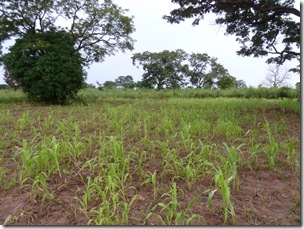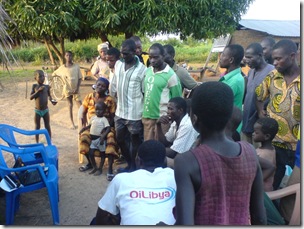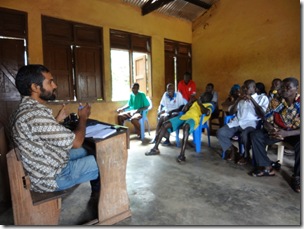Today is World Food Day.
This year’s theme on food price volatility is an important one – more than 70 million people have fallen into extreme poverty over the last year due to rising food costs. Volatility in food prices remains a very real threat to vulnerable people across the developing world, with some economists predicting continued rises in staple crops even past the historically high levels seen between 2005 and 2008.
When I learned of this year’s World Food Day theme, I couldn’t help but think of how my current work with Engineers Without Borders in Ghana tied into the overall question of food price volatility. A large part of my work over the last seven months here has been focused on understanding and developing innovative ways to increase technology adoption with small-scale farmers. I’ve mainly been trying to understand why farmers are not adopting certain good agronomic practices, like row planting or proper seed spacing, which have been proven to increase agricultural productivity (or the ratio of outputs to inputs). This, as I see it, is an important step in mitigating against future price volatility in staple foods, at least at the farmer level. Increases in agricultural productivity can increase access to local food as well as the incomes of smallholder farmers.
From visiting farmers’ fields in different regions of Ghana, I’d see the potential for higher productivity for most crops in the country, but continued to question why greater yields were not being realized. I was stunned after reading a recent University of Cape Coast study which stated that although the vast majority (more than 90%) of farmers in Ghana were aware of agricultural production practices such as row planting, proper spacing and timely weeding, adoption of these practices remained relatively low. These results matched well with what I was seeing on the ground, but didn’t seem to make intuitive sense to my engineering mindset. How was it that farmers who were aware of techniques or practices that could benefit them greatly not be practicing these same techniques?


Sorghum field planted in rows (left) versus using traditional broadcasting method (right).
Enter Sendhil Mullainathan, a Professor of Economics at Harvard University. In his TED talk from last year, he speaks of this exact phenomenon, calling it a “Last Mile” problem. Basically, he states that even in the face of the “perfect” technological solution to a problem, human beings might still need to be convinced to actually use the technology due to a potential conflict with their mental models.
An example from my work: Many farmers I’ve met understand how to plant their crops in rows and know that by doing so, they’ll achieve greater yields (all else being equal). They’ll also say when asked that row planting takes a lot more time than the traditional method of broadcasting seed (basically walking through the field and tossing seed onto the ground), which is true. Does this mean that the farmers are lazy? Hardly. These farmers actually prefer to increase the size of their fields, believing it to be a better indicator of success. This practice, however, can be detrimental in the long run, since it actually leads to more time spent weeding and harvesting over the full growing season.
After realizing this, I was interested in experimenting with whether or not this type of behaviour could be changed and the best way to go about it. I thought that by using another farmer who was successfully using the practices to spread the message, the potential for change with colleague farmers would be greater. In essence, I wanted to convince farmers to adopt a new technique by listening to one of their own. I tested this idea by using video testimonials of farmers who were successfully transplanting and row planting their rice and showing it to other groups of farmers who were aware of the practices of transplanting and row planting, but not interested in actually doing them (mainly due to a perceived increase in time requirements). Results were positive, with around 78% of farmers who saw the video being interested in trying the techniques during the next cropping season (more detail can be found in the following briefing paper).


Testing video testimonials with rice farmers.
This was a situation where the technologies were sound – they’d been tried and tested for decades – and yet farmers were not willing to actually use them on their fields. It wasn’t a question of just throwing the techniques at farmers and expecting them to use them, believing that because it was the rational choice, it would actually be followed. This came down to understanding that farmers sometimes need to be convinced to use an agricultural practice and that listening to a fellow farmer might be a good way to get the message across.
What does this mean for those interested in combating future food price volatility for a growing global population? Apart from the policy and funding shifts that are required at the international and national levels, we need to step back and re-visit some of our core assumptions at the farmer level. To start, we need to develop a much better understanding of why current agricultural best practices are not being adopted by a large percentage of small-scale farmers across Ghana and the rest of Africa. As Mullainathan says:
“We tend to think the problem is solved when we solve the technology problem. But the human innovation, the human problem still remains, and that’s the great frontier that we have left.”
Without spending the time and effort required to address the social and psychological challenges surrounding these issues and developing successful behaviour change strategies towards overcoming them, the true potential of African agriculture will never be realized and the effects of price volatility will remain a persistent problem in many of these countries for years to come.

my idea: the green wall against the desert!
Hi Don- this is a really fascinating post. It’s all about communication! Also – I suppose there’s a question in the farmers’ minds as to who is most likely to be right? Outsiders with a new approach or centuries of tradition and local expertise? Great reading though- sounds like you’ve got a brilliant job!
We’re definitely trying to be sensitive to the farmers’ own wants and not trying to impose anything on them. I’m mainly looking at technologies that are being used in different parts of the country successfully, but haven’t spread to the extent that they should have.
No complaints on the job front so far!
Hi Don, thanks for the great post! I’ve check the TED and the briefing paper, both very interesting. Are you planning on checking the actual adoption rates of the row planting in the test villages? Are there other behavior changes hypothesis being tested in your team or other teams that you are aware of?
Hey Guillaume! The plan is to check up on the farmers that were part of this experiment if possible during the dry season (next February) to see the rate of actual adoption versus gauged interest. I’m already slightly concerned about spillover effects as more farmers have now been discussing the idea and there are likely going to be more people willing to try it out than actually saw the video. In the end, not sure how valid the end results are going to be which is why i decided to write the paper at this point.
I see the majority of our work as related to behaviour change. Both our team and the Agricultural Value Chains team are working closely with trying to understand how to influence different behaviours in the sector. AVC members Mina Shahid and David Taylor are working with the Savannah Agricultural Research Institute (SARI) on improving access to fertilizer and improved seeds, respectively. This is more behaviour change at the input dealer level. Siera Vercillo is currently looking into farmer-to-farmer learning mechanisms and how they can be leveraged by MoFA staff to spread technologies and Janine Reid is testing out a cool pictorial contract tool to see the effects on repayment rates for a national farming program. If you want more specifics, just ask.
All very interesting! Thx for the info. I’m particularly curious about the pictorial contract tool because some past Burkina JF have noticed that farmer groups.were having a hard time with the UN’s world food program (P4P) contracts.
I think what you guys are doing is very meaningful when it comes to understanding what works and what doesn’t in the aid sector. The monitoring and evaluation part is crucial to approaching poverty in a scientifical and methological way and we often talk about how it is overlooked, with IATI for exemple.
On a more technical side, I found some inspiration about randomized controls method when I watched this TED of Esther Duflo of Poverty Action Lab (https://www.youtube.com/watch?v=0zvrGiPkVcs&feature=player_embedded#!). Is this kind of control group approach being tried right now within EWB?
Thank you for your time!
Guillaume
The contract tool is really interesting. The idea is to test whether higher repayment rates can be achieved by using a pictorial contract with (mainly) illiterate farmers. One of our main assumptions is that farmers entering the program are just not aware of how much they’ll need to repay and if they knew about the actual amount they’ll be required to repay, they’d be more willing to do it come harvest time. It’s being tested in one district right now, but there’s been some really good feedback from other districts and others at the Ministry of Food and Agriculture and we think there’s the potential to scale it up next year.
On RCTs – I think they’re great and we’re definitely trying to be more intentional/rigorous about our testing, but a true randomized trial takes a lot more resources than are available to us at this time. We’ve even had IPA , run a session at our DDA Fellowship meetings on impact evaluations to get district directors thinking about new ways to design and measure the impacts of their projects.
Not sure if you’ve seen their new book (Duflo/Banerjee) called Poor Economics. I haven’t had a chance to read it yet, but will be picking it up when I get back to Canada in a few months. There’s a good introduction in this podcast to their ideas.
Great post Don!
This is so interesting. Came across this via Blog Action Day. I look forward to following your blog.
Best Wishes
Don seriously great post man! Loved the cross section of high level ideas and real field level examples. Your articulation around the need to take a behaviour change lens are super sharp – big ups!
The TED talk is wicked too! I feel like we should put “behavioural economist” in our criteria for new APS!
Pingback: Development Digest – 28/10/11 « What am I doing here?
Pingback: Challenging Perspectives – Extending a Hand Up « What am I doing here?